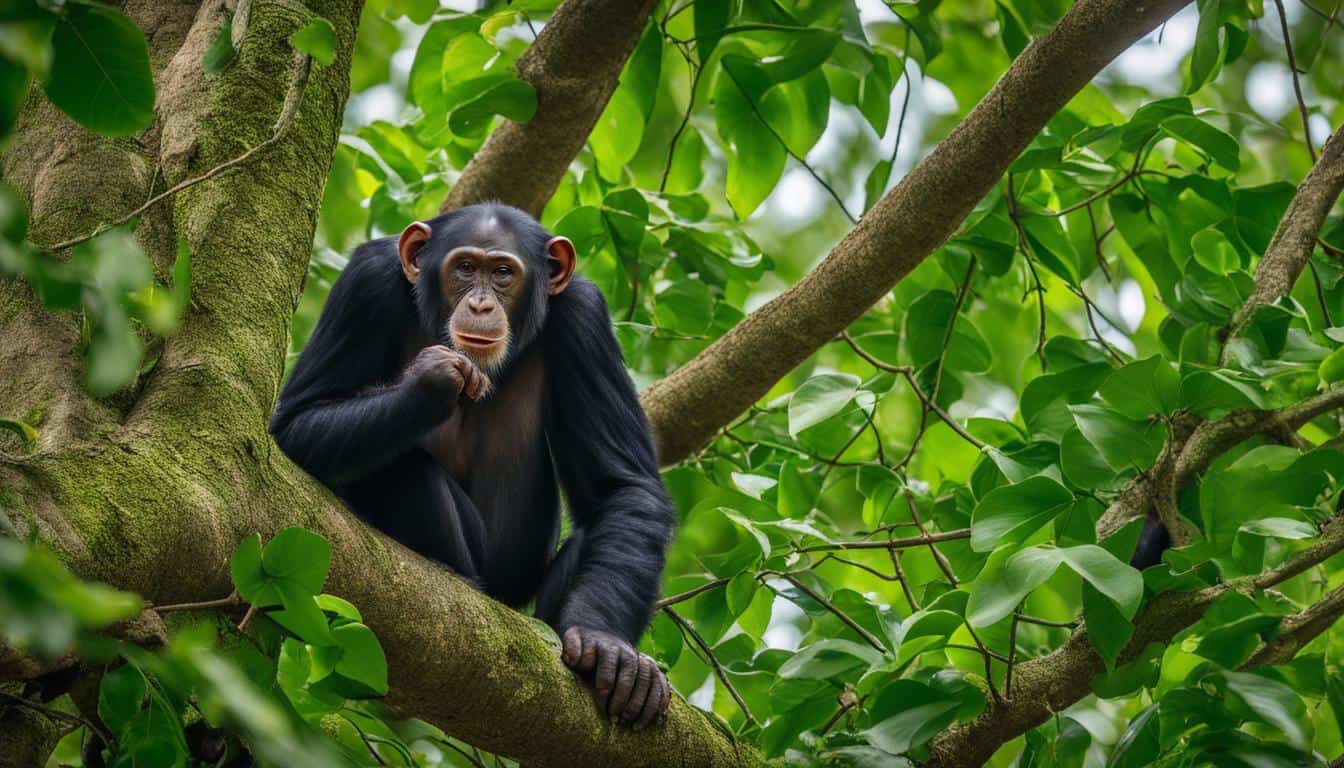Chimpanzees, among other hominid apes, have a fascinating behavior of building nests for sleeping and resting. Nest-building is a learned behavior passed down from adults to infants. It is considered a form of tool use and is estimated to have originated during the Miocene period when the ancestors of modern apes increased in size and needed a safe and comfortable place to sleep.
Chimpanzees construct their nests primarily for resting during the day or at night. These arboreal nests are built by lacing together branches from one or more trees, creating a mattress-like structure lined with soft leaves and twigs. The nests are typically built in trees with a minimum diameter of 5 centimeters and can be located at varying heights. Both day and night nests are built, and nests may also be found in groups.
| Nest-Site Selection Factors | Predation Risk | Environmental Conditions |
|---|---|---|
| Chimpanzees in predator-rich environments | Higher and more peripheral nesting locations in trees | Consideration of insulation and stable support structures |
| Chimpanzees in areas with lower predation risk | Ground-nesting | Selecting stable and insulated locations |
Nest Specifications and Nesting Materials
Chimpanzee nests are meticulously constructed with specific specifications and incorporate a range of materials. These nests serve as a comfortable haven for these intelligent primates, providing insulation and protection from the elements.
The foundation of a chimpanzee nest is made up of interwoven branches, forming a stable and secure structure. This strong base supports the entire nest, ensuring its durability. Nest construction requires strategic weaving and lacing of branches to create a sturdy framework.
Soft leaves and twigs are carefully selected and used to line the inner surface of the nest, providing cushioning and comfort for the chimpanzees. The arrangement of these materials creates a mattress-like structure that enhances the nesting experience.
Chimpanzees also display a level of ingenuity in their nest construction, often adding additional features to their night nests. These features include “pillows” made of clumped leafy branches or “blankets” made of larger leafy branches. These additions enhance the overall comfort and insulation of the nest, allowing for a more restful sleep.
Interestingly, orangutans, another type of hominid ape, exhibit similar nest-building behaviors. They too create nests with “pillows,” “blankets,” and even overhead shelters. These shared characteristics highlight the commonalities between different primates in their nesting habits.
| Nest Specifications | Nesting Materials |
|---|---|
| Interwoven branches | Soft leaves |
| Sturdy and stable foundation | Twigs |
| Mattress-like structure | Clumped leafy branches (pillows) |
| Large leafy branches (blankets) |
Note: The table above summarizes the nest specifications and nesting materials used by chimpanzees for constructing their nests.
This careful selection of nesting materials and the construction techniques employed by chimpanzees may vary depending on factors such as environmental conditions, predation risk, and individual preferences. Their ability to adapt their nests to different circumstances showcases the remarkable intelligence and resourcefulness of these fascinating primates.
Evolution and Importance of Nest-Building Behavior
Nest-building behavior has played a crucial role in the evolution of sleep patterns among hominoids, or ape-like species. It is believed that the transition from ground-sleeping to nest-building brought about modifications in sleep quality and quantity, leading to enhanced survival skills, increased creativity, and improved memory consolidation.
This unique behavior holds significance not only for individuals but also for estimating population counts and composition in hominid apes. By studying nest-building behavior in primates, including our closest relatives, the chimpanzees, we gain valuable insights into the evolution and adaptive value of this behavior.
The origin of nest-building behavior can be traced back to the Miocene period when the ancestors of modern apes increased in size and required a safe and comfortable place to sleep. Nest-building served as a cognitive advancement and contributed to the development of complex sleep patterns observed in primates today.
Understanding the evolution and importance of nest-building behavior offers valuable knowledge about the sleep patterns and cognitive abilities of primates, shedding light on our own evolutionary journey and providing a deeper appreciation for the intricate behaviors that shape our lives.
Do Chimpanzees Build Nests as Part of Their Reproduction Cycle?
Yes, chimpanzees build nests as part of their chimpanzee reproduction cycle. Female chimpanzees use these nests for resting and giving birth. The construction of nests is vital during the mating and pregnancy stages, providing a safe and comfortable environment for the young and their mothers.
Do Chimpanzees Build Nests in the Same Locations Where They are Found in the Wild?
Yes, chimpanzees build nests in the wild habitats of chimpanzees in the same locations. These nests are used for sleeping and resting and are usually built in trees using branches and leaves. Chimpanzees construct new nests each night to avoid predators and maintain hygiene.







